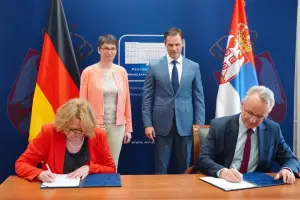- Serbia
Get to know Serbia
- Citizens
Culture and science
Health services
Pension and disability insurance
- Business
Employment
Economy
- Media
- Government
- Contact
Keep in touch
Contact form
Back
Keepin touch
Whether you have a question, comment, suggestion or any problem in the purview of the government, send us your message and we will try to respond as soon as possible. If your problem is not in our purview, we will forward your message to the relevant institution.
Q:
A:
More than $1 billion foreign direct investment since the beginning of year
Belgrade,
29 September 2005
Director of the Serbian Investment and Export Promotion Agency (SIEPA) Jasna Matic said today that since the beginning of the year, Serbia has received more than a billion dollars in foreign direct investment, and the government anticipates this amount to reach $2 billion by the year’s end.
At a presentation of the UNDP’s report on international investments in 2005, Matic said that in the upcoming period there will be an investment boom in Serbia, particularly thanks to Serbia’s leading position in the region, its qualified workforce and industrial potential.
According to Matic, in the past several years there has been a constant increase in foreign direct investment in Serbia, and it is expected to reach a record this year, while the next year this number can be even higher, though this will depend on the success of privatisation of public companies.
According to the World Bank, Serbia has achieved the best results in the implementation of reforms in business in relation to other countries, but it has not yet been included in the UNDP research, Matic said.
She stressed that Serbia has to turn to innovation and exploration techniques if it is to become competitive and attract more foreign investment.
According to Matic, Serbia must focus on the EU and on its relatively sophisticated workforce that will be able to produce complicated products and then dispatch them to European countries expediently and on time.
Along with the improvement of human resources, Serbia also needs to work on improving its regulative framework, as well as the telecommunications sector, because globalisation, research and development are solely the result of the advancement of telecommunication technologies. Therefore we need to start a process of serious reformation and privatisation of the telecommunications sector, said Matic.
Head of the Managing Board of the Societe General Bank Goran Pitic pointed out that the major part of foreign investment in the world goes into the sector of financial services. This proves that Serbia does not lag behind the rest of the world, because the year 2005 will certainly be marked by an inflow of investment, especially in the banking sector.
The UNDP deputy standing representative to Serbia-Montenegro Rastislav Vrbensky said that the UN report on world investment in 2004 shows that the inflow of foreign direct investment on global level, after it had been decreasing for three years, in 2004 rose by two percent, totalling $648 billion. He said that the inflow of investment in developing countries has risen by 40 percent, totalling $233 billion, which is the second highest figure ever, adding that the money did not go only to India and China, but to southeastern Europe as well, which is increasingly becoming a target for direct investment.
Vrbensky said that big transnational corporations, which contribute two-thirds of all investment throughout the world are turning toward the markets of developing countries.
According to Matic, in the past several years there has been a constant increase in foreign direct investment in Serbia, and it is expected to reach a record this year, while the next year this number can be even higher, though this will depend on the success of privatisation of public companies.
According to the World Bank, Serbia has achieved the best results in the implementation of reforms in business in relation to other countries, but it has not yet been included in the UNDP research, Matic said.
She stressed that Serbia has to turn to innovation and exploration techniques if it is to become competitive and attract more foreign investment.
According to Matic, Serbia must focus on the EU and on its relatively sophisticated workforce that will be able to produce complicated products and then dispatch them to European countries expediently and on time.
Along with the improvement of human resources, Serbia also needs to work on improving its regulative framework, as well as the telecommunications sector, because globalisation, research and development are solely the result of the advancement of telecommunication technologies. Therefore we need to start a process of serious reformation and privatisation of the telecommunications sector, said Matic.
Head of the Managing Board of the Societe General Bank Goran Pitic pointed out that the major part of foreign investment in the world goes into the sector of financial services. This proves that Serbia does not lag behind the rest of the world, because the year 2005 will certainly be marked by an inflow of investment, especially in the banking sector.
The UNDP deputy standing representative to Serbia-Montenegro Rastislav Vrbensky said that the UN report on world investment in 2004 shows that the inflow of foreign direct investment on global level, after it had been decreasing for three years, in 2004 rose by two percent, totalling $648 billion. He said that the inflow of investment in developing countries has risen by 40 percent, totalling $233 billion, which is the second highest figure ever, adding that the money did not go only to India and China, but to southeastern Europe as well, which is increasingly becoming a target for direct investment.
Vrbensky said that big transnational corporations, which contribute two-thirds of all investment throughout the world are turning toward the markets of developing countries.
-
 Belgrade/Athens, 17 July 2025
Belgrade/Athens, 17 July 2025Serbia continues to align with EU in field of energy
-
 Kostolac, 14 July 2025
Kostolac, 14 July 2025First solar power plant Petka in Kostolac put into trial operation
-
 Belgrade, 11 July 2025
Belgrade, 11 July 2025Potential for improving cooperation with Belarus in many areas
-
 Požega, 5 July 2025
Požega, 5 July 2025Section of Pakovraće - Požega highway officially opened
-
 Belgrade, 2 July 2025
Belgrade, 2 July 2025Technical specifications defined for Serbia-Hungary oil pipeline
-
 Belgrade, 30 June 2025
Belgrade, 30 June 2025IMF confirms Serbia successfully implementing all agreed reforms
-
 Belgrade, 27 June 2025
Belgrade, 27 June 2025Double Taxation Avoidance Agreement with Germany signed
-
 Kostolac, 25 June 2025
Kostolac, 25 June 2025Construction of Kostolac wind farm nearing completion
-
 Belgrade, 24 June 2025
Belgrade, 24 June 2025Government supports request for new postponement of sanctions against NIS
-
 Belgrade, 23 June 2025
Belgrade, 23 June 2025Procedures to facilitate sale of Serbian products to China to be accelerated
